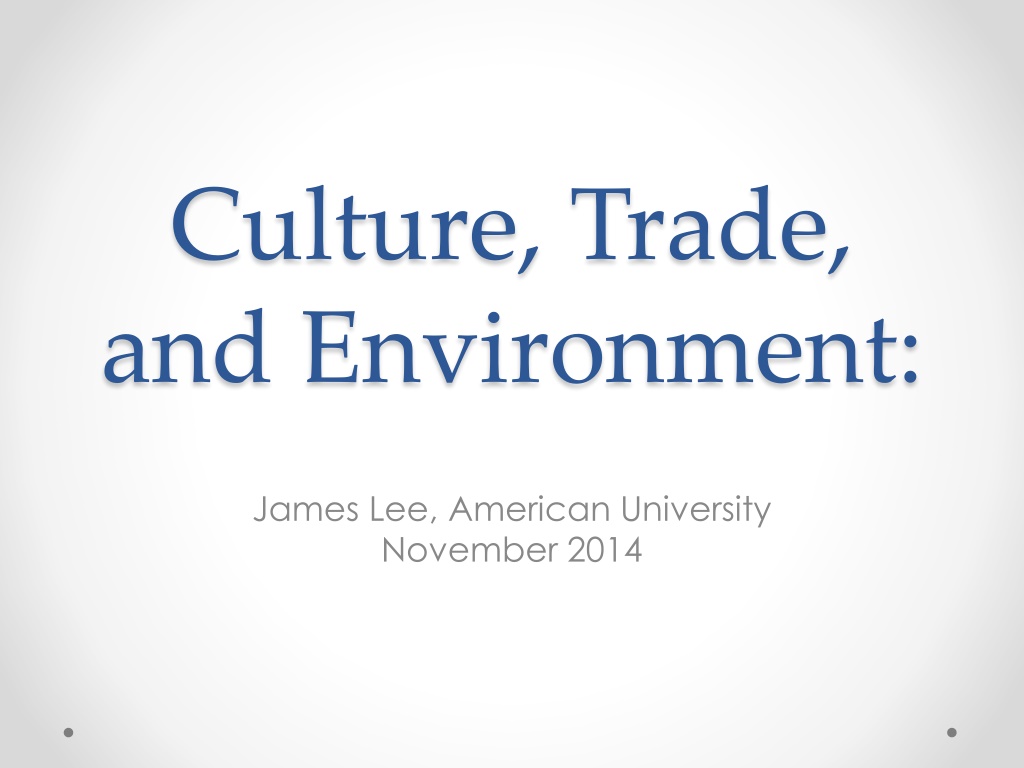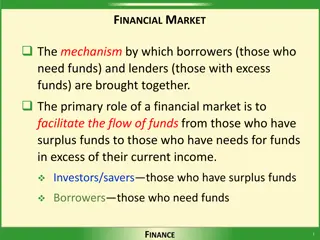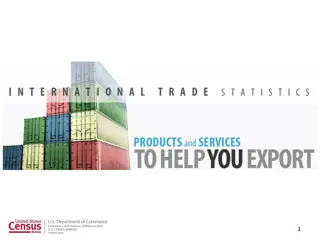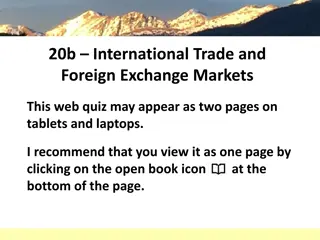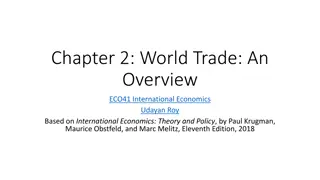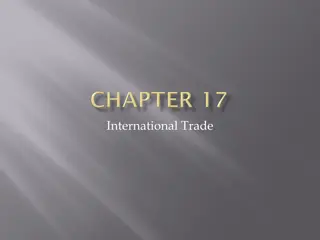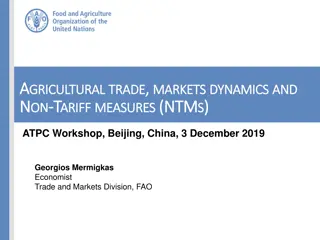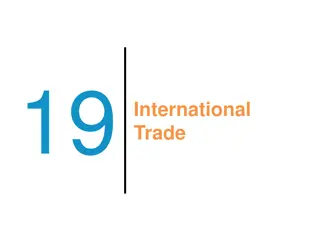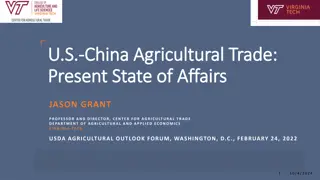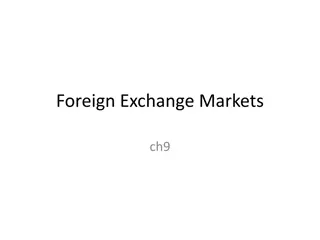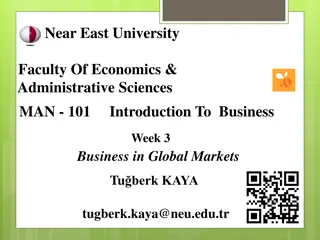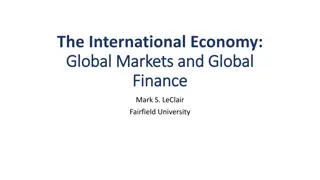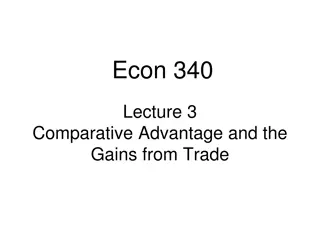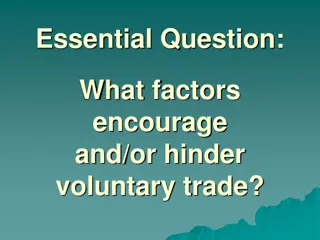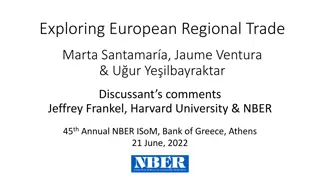Trade, Environment, and Culture: Interplay in Global Markets
Explore the intricate relationship between trade, environment, and culture in the global arena with a focus on trade rules, environmental concerns, and cultural exceptions affecting international trade. Delve into cases, examples, and discussions on how these factors intersect and impact global market dynamics.
Download Presentation

Please find below an Image/Link to download the presentation.
The content on the website is provided AS IS for your information and personal use only. It may not be sold, licensed, or shared on other websites without obtaining consent from the author. Download presentation by click this link. If you encounter any issues during the download, it is possible that the publisher has removed the file from their server.
E N D
Presentation Transcript
Culture, Trade, and Environment: James Lee, American University November 2014
Moving Trade Rules Beyond Tariffs 1. Post WW2 and Depression: The Growth of GATT, and the Creation of WTO (GATT, World Bank, and IMF, meeting in Havana) 2. Focus on Lowering Tariffs and Extending Members (23 members in 1947; goal to reduce tariffs by 50%, 6 subsequent trade rounds) 3. The Rise of Environmental and Cultural Non-Tariff Barriers (and Labor)
Some Trade and Environment Cases Japan Apple Import Ban US Mexico Tuna-Dolphin Case US Ban on Immature Canadian Lobster EC Ban on Canadian Lumber for Nematodes Environmental Beer Taxes (Cans): Ontario, Canada US Ban on Venezuelan Gasoline Imports US Sanctions on Taiwan for End. Species Trade (*Tiger Pills) US Shrimp and Sea Turtle Protection US Ban on Japanese Driftnets From James Lee, How Much is a Dolphin Worth? 1. 2. 3. 4. 5. 6. 7. 8. 9.
Now Lets Add Culture: Definitions and Concepts What is culture? The customs, arts, social institutions, and achievements of a particular nation, people, or other social group What is cultural trade? GATT/WTO puts it under the category of personal, cultural, and recreational services. EU largest exporter, followed by US. It is regarded as a non-tariff trade barrier in trade rules. Cultural Exceptions to Trade: Initiated by France in 1993 in basic WTO talks Culture and Customs: defining health and safety in context; i.e., legitimate ban on-kosher/halal meat imports in Israel and Saudi Arabia
Culture and Trade Examples (TED Cases) The US-Canada Country Music Feud and Cultural Trade Protection http://www1.american.edu/TED/cmtvcan.htm Sports Illustrated Magazine Sales in Canada and Trade Quotas on Cultural Productshttp://www1.american.edu/TED/sportsil.ht m French TV Broadcast Quotas and Cultural Protection http://www1.american.edu/TED/frenchtv.htm
Trade, Environment and Culture Cases: Culturally Appropriate or Barriers to Trade? EU Ban on Furs Caught in Leg Traps or Baby Seals US Ban on Exports of Bear Parts to China CITES Listings regarding Ivory Trade and Elephant Decline (and the Mammoth Ivory Problem) Hawksbill Turtle and US Sanctions on Japan (Bekko Industry) US Ban on Shark Finning in US Waters; Sharkfin Soup Bats in Guam, Species Protection under CITES and Lacey Act, and Trade Cases are from Trade Environment Database (TED) http://www1.american.edu/ted/
Overview of Geographic Indications Protection of GIs date back to perhaps 1500 and French attempts to protect Burgundy wines from cheap British imitations. Wines and spirits have longest tradition. EU uses GI to protect. PDO (origin or process) or PGI (geographic place). Over 1,000 GIs recognized (including non EU country applications) US, Canada and other users trademarks (not patents). NAFTA does contain protected spirits clause covering Canadian Whiskey, Kentucky Bourbon, and Tequila, among others. No progress on WTO agreement in general and on GIs in particular.
How the EU Protects Food Products Protected Designation of Origin - PDO: covers agricultural products and foodstuffs which are produced, processed and prepared in a given geographical area using recognized know-how. Protected Geographical Indication - PGI: covers agricultural products and foodstuffs closely linked to the geographical area. At least one of the stages of production, processing or preparation takes place in the area. Traditional Speciality Guaranteed - TSG: highlights traditional character, either in the composition or means of production From EU web site
Some GI cases Basmati Rice (*Texmati)http://www1.american.edu/TE D/basmati.htm Maryland Crab (*Maryland Style)http://www1.american.edu/TED/blu ecrab.htm Parmigiano-Reggiano Cheese http://www1.american.edu/TED/ parmesan.htm Darjeeling Tea: Places and Seeds Darjeeling (*)
Some PDO/TSG cases Ingredients: German Beer Purity http://www1.american.edu/TED/g ermbeer.htm Labeling: Mayan Sweet Onions from Peru (*) Pisco Liquer http://www1.american.edu/TED/pi sco.htm
Are there Common Principles for Culture and Environment? 1. The Right to Survive 2. The Right of Diversity 3. The Least Distorting Path 4. Pursuit of Sustainability 5. Ownership is a Right
Concepts for Discussion How do we reconcile trade efficiency, cultural norms, and environmental protection? Are they equal shares? Is the WTO dispute settlement mechanism capable of adjudicating complicated disputes involving trade, environment and culture?
